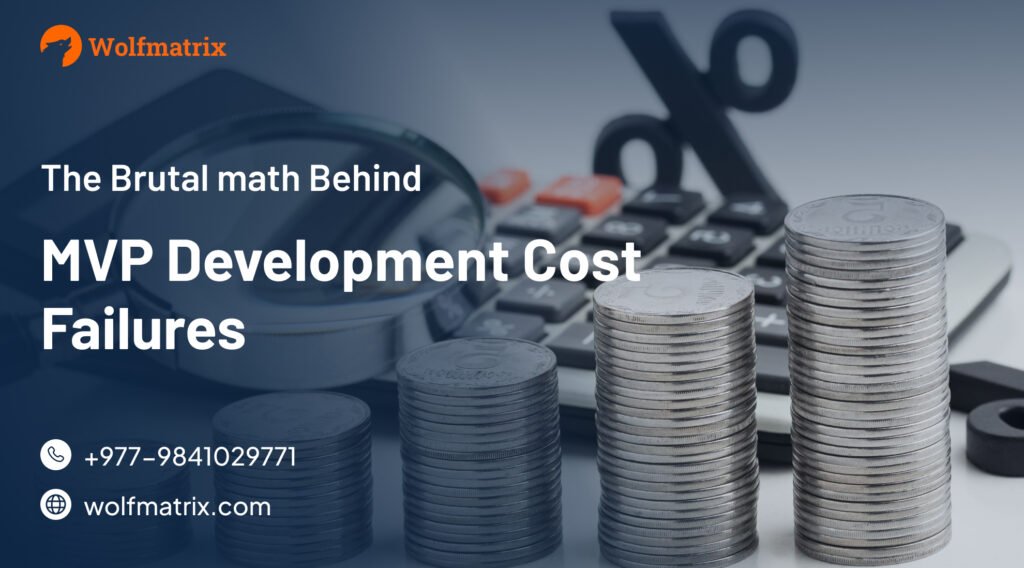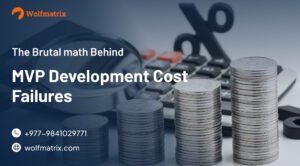Why 80% of Startups run out of money before finding Product-Market Fit
Your $50,000 MVP development cost estimate just became $125,000. And you still haven’t launched.
Sound familiar? Here’s what actually happened: You spent six months and every dollar building features, launched with $2,000 left for marketing, discovered users want something completely different, and now you’re out of runway with no budget to iterate.
This isn’t a nightmare scenario, it’s the mathematical reality for most startups, as more than 80% allocate over 80% of their total budget to MVP development, leaving nothing for the activities that actually determine success: marketing, user acquisition, and post-launch iteration.
But here’s where it gets interesting: 42% of projects fail due to the lack of market demand, yet founders continue making the same catastrophic budgeting error that guarantees they’ll never discover what the market actually wants.
Meanwhile, a specific subset of businesses, Australian logistics companies, have quietly figured out a completely different approach to MVP development cost allocation that’s generating 300% growth rates while reducing operational expenses by 45%. They’ve cracked the code that most startups miss entirely.
Let me show you the brutal math that’s killing startups and the counterintuitive solution that’s saving them.
The $80,000 mistake: How hidden costs destroy Startups
After your startup app launches, security measures, infrastructure, maintenance, legalities, and marketing costs can add up to 40% of the total development budget. Most founders don’t account for this 40% hidden tax when calculating MVP development cost. They think development ends when developers hand over the code.
It doesn’t. It’s just beginning.
The Real Numbers Nobody Warns you about
Let’s run the actual math on a typical startup budget disaster:
Total Available Capital: $100,000
Traditional Allocation:
- Development: $80,000 (80%)
- Marketing at Launch: $5,000 (5%)
- Iteration Budget: $5,000 (5%)
- Operations/Survival: $10,000 (10%)
Reality Check:
- Month 1-6: Build features based on assumptions ($80K spent)
- Month 7: Launch with minimal marketing ($5K spent)
- Month 8: Discover users want different features
- Month 9: Need $30K for critical changes you can’t afford
- Month 10: Out of business
In 2025, building a Minimum Viable Product typically costs startups between $10,000 and $50,000, but countless startups fail because they either ran out of money by overspending on unnecessary features, spent resources in the wrong areas ignoring user feedback, or underestimated costs for hosting, compliance, or post-launch fixes.
The math is brutal and unforgiving. Yet 80% of startups walk straight into this trap.
The Hidden 40%: Post-Launch costs that kill MVPs
Here’s the mathematical reality most founders discover too late: planning your budget without considering the 40% hidden costs can cause resource creep for your venture.
Breaking down the 40% hidden tax
Infrastructure Costs (10% of development budget):
- Cloud hosting: $200-$2,000/month depending on scale
- CDN and media storage
- Database management
- SSL certificates and domain costs
Security & Compliance (8% of development budget):
- Security audits and penetration testing
- GDPR/CCPA compliance implementation
- Data encryption and backup systems
- Insurance for tech companies
Maintenance & Technical Debt (12% of development budget):
- Bug fixes from real user testing
- Performance optimization
- Third-party API updates
- Emergency patches and security updates
Marketing & User Acquisition (10% of development budget):
- Minimum viable marketing campaigns
- Analytics tools and tracking
- Initial customer acquisition
- Landing page optimization
Add it all up: Your $50,000 MVP development cost realistically requires $70,000-$75,000 when accounting for the 40% hidden expenses. But most founders only budget the initial $50K, guaranteeing they’ll run out of money at the worst possible time right after launch when user feedback could actually save the product.
The 30-20-30-20 Rule: How Smart Founders actually Budget
Considering about one-third of startups fail because they run out of cash, businesses must budget accurately for MVP development. Here’s the allocation framework that actually works, based on analysis of successful startups and high-performing logistics implementations:
The Survival Budget Framework
30% – Initial Development For a $100K total budget, allocate only $30K for initial build. This forces ruthless prioritization of core features only.
Example: Instead of building 15 features, you build the 3 features that test your core hypothesis. Entrepreneurs often overload MVPs with “nice-to-have” features, escalating costs unnecessarily, while the ideal MVP tests only your core hypothesis.
20% – Launch Marketing & Initial Acquisition You need users to validate assumptions. Campaigns often invest heavily in digital marketing expenses such as SEO, PPC, and social media advertising, which can account for approximately 30% of the overall marketing budget. But for MVPs, 20% enables basic customer acquisition to get your first 100-500 users generating meaningful feedback.
30% – Iteration & Improvement This is where startups traditionally fail. Research shows successful startups spend approximately 50% of their initial development budget on improvements in the first year after launch. Reserve substantial budget for rapid iteration based on real user feedback.
20% – Operations & Runway Cloud hosting, customer support, bug fixes, and keeping lights on while you figure things out. Boring but essential for survival.
Why this changes everything?
With only 30% allocated to initial development, you’re mathematically forced to make better decisions:
Team Selection: Freelancers cost about $13,000 per month, MVP development by an in-house team comes with a price of approximately $25,000 per month, while outsourced development of an MVP will cost up to $35,000 per month. Suddenly, strategic outsourcing becomes non-negotiable.
Technology Stack: Cross-platform solutions like Flutter or React Native let you write one codebase for both platforms, potentially cutting costs by up to 40%. You can’t afford separate iOS and Android builds.
Feature Ruthlessness: You eliminate anything that doesn’t directly test your core hypothesis. To prevent feature creep, many startups use the MoSCoW method: Must-have features for the core hypothesis, Should-have important but not critical features, Could-have nice-to-have features, and Won’t-have features unnecessary for this phase.
Logistics Custom Software Development in Australia: The Unexpected Case Study
While tech startups burn cash on bloated MVPs, Australian logistics companies are taking a radically different approach to MVP development cost that’s generating measurable results within months.
The Australian logistics automation market generated revenue of USD 725.8 million in 2023 and is expected to reach USD 1,800.8 million by 2030—a 2.5X expansion in seven years. But what makes this market instructive isn’t the growth—it’s how successful companies approach building custom software.
The “Minimum Viable Disruption” Philosophy
Instead of trying to solve every logistics problem at once and creating massive, complex systems that take years to develop, smart Australian logistics companies start with one critical pain point, solve it brilliantly, then expand systematically.
Real Example: A Sydney-based logistics company partnered with an Australian development team in Nepal to build their warehouse management system. Result: Launched 6 months ahead of schedule, saved AUD 180,000 in development costs, and achieved 99.7% system uptime in the first year.
Notice what they didn’t do: Build a perfect, feature-complete system. They built something focused, launched fast, validated with real users, and expanded from there—exactly matching the 30-20-30-20 budget allocation philosophy.
Another Example: A Melbourne e-commerce company created a system that automatically reroutes deliveries based on weather predictions, traffic patterns, and customer preferences. The outcome: 40% reduction in delivery complaints and 25% increase in customer satisfaction scores.
They didn’t build comprehensive fleet management, advanced analytics, or AI-powered forecasting. They solved one critical problem that generated immediate, measurable ROI—then expanded.
This is logistics custom software development in Australia done right: focused, validated, and financially sustainable.
The three fatal assumptions destroying your budget
MVP development plays a crucial role in startup success because 90% of startups fail, and 34% of those failures result from poor product-market fit. Most of these failures stem from three mathematical impossibilities disguised as business plans.
Fatal Assumption #1: “We’ll get it right the first time”
The Math: If you spend 80% of your budget building version 1.0, you have 20% left for everything else: marketing, iteration, operations, and survival.
The Reality: 42% of AI startup failures cite market misfit, and traditional startups fare no better. Your first version will be wrong. That’s not pessimism, it’s statistics.
The Solution: Allocate only 30% to initial development, forcing yourself to build the minimum that tests your hypothesis, not your complete vision.
Fatal Assumption #2: “Development ends at Launch”
The Math: Planning your budget without considering the 40% hidden costs can cause resource creep. Security, infrastructure, maintenance, and compliance aren’t optional, they’re mandatory costs that appear the moment you launch.
The Reality: Each testing phase :alpha, beta, and post-launch iterations adds to your MVP’s development cost, but skipping any step risks poor user adoption.
The Solution: Budget the 40% hidden tax from day one. Better to build less initially and have resources for post-launch activities than build more and run out of money when users finally engage.
Fatal Assumption #3: “More Features = More Value”
The Math: Each additional feature increases MVP development cost by 15-20% and adds 2-4 weeks to timeline. Five “nice-to-have” features can double your budget and triple your timeline.
The Reality: One of the biggest mistakes when building an MVP is jumping straight into development without clear metrics. Founders add features because they sound cool, not because they validate critical hypotheses.
The Solution: Define success metrics before writing a single line of code. What exactly will prove your hypothesis? How many users? What retention rate? What conversion percentage?
The cost optimization framework that actually works
Gartner’s new report on “Forecast Analysis: Low-Code Development Technologies, Worldwide” predicts 70% of new apps will use low-code or no-code platforms to cut costs and speed delivery, but cost optimization goes deeper than technology choices. Here’s the systematic approach based on real startup successes:
Step 1: Calculate Your True Available Capital
Don’t confuse raised capital with available capital for development.
Formula: True Available Capital = Total Raised – (Operating Expenses × 12 months) – Emergency Reserve (10-15%)
Example:
- Raised: $200,000
- Operating expenses: $8,000/month
- Emergency reserve: $30,000
- True Available for MVP: $200K – $96K – $30K = $74,000
Step 2: Apply the 30-20-30-20 Split
Using the $74K example:
- Initial Development: $22,200 (30%)
- Launch Marketing: $14,800 (20%)
- Iteration Budget: $22,200 (30%)
- Operations: $14,800 (20%)
Step 3: Force feature ruthlessness
With only $22,200 for initial development, you physically cannot build everything. Good. This forces the right decisions.
PayPal (originally launched by Confinity, then merged with X.com) mentioned in a case study. The company pivoted from handheld-device software to focusing on payments (wallet) before expanding internationally. They started with core features (payments, transfers) before building full-scale analytics/reporting, showing the importance of narrowing scope to launch faster and cheaper.
Step 4: Choose Strategic Development Partners
Freelancers often charge lower rates than established companies, making this option more budget-friendly, especially for startups, though managing a dispersed team can present challenges in communication and coordination.
For logistics custom software development in Australia or any specialized domain, choosing partners who understand both rapid iteration and industry-specific needs determines success more than any other factor.
At Wolfmatrix, we’ve helped dozens of businesses navigate exactly these challenges from general MVP development to specialized logistics solutions that transform industries.
Step 5: Build in Iteration cycles from Day One
Release your MVP on agile development principles that allow you to iterate quickly and continue to incorporate feedback, breaking development into short sprints with well-defined outputs.
Your 30% iteration budget isn’t optional, it’s what separates successful products from expensive failures.
Real-World Budget Breakdown: Two Paths, Two Outcomes
Let’s compare two identical startups with $100K in funding:
Startup A: Traditional Approach (Fails)
- Months 1-6: Spends $85K building 12 features based on assumptions
- Month 7: Launches with $5K marketing budget, gets 200 users
- Month 8: Users want 5 different features, none of which exist
- Month 9: Has $10K left, needs $40K for changes
- Month 10: Out of business
Total Money Spent: $100K
Learning: Discovered product assumptions were wrong
Result: Failed startup, no pivot possible
Startup B: 30-20-30-20 Approach (Succeeds)
- Months 1-3: Spends $30K building 3 core features testing primary hypothesis
- Month 4: Launches with $20K marketing, acquires 500 users
- Months 5-6: Analyzes real user behavior, discovers 2 features users love, 1 they ignore
- Months 7-8: Spends $30K iteration budget improving the 2 features users love
- Months 9-12: Revenue starts flowing, product-market fit emerging
- Month 13: Raises Series A based on actual traction
Total Money Spent: $80K (still has $20K operations reserve)
Learning: Discovered what users actually want, validated business model
Result: Product-market fit, fundable business, sustainable growth
The difference? Mathematical discipline in budget allocation.
The Five Non-Negotiable Budget Rules
Based on analyzing more than 50 successful and failed MVPs, these five rules separate winners from the 90% who fail:
Rule #1: Limit Development to 30% of Total Capital One of the most frequent and undermining mistakes in building an MVP is allocating more than 80% of the whole budget into MVP development, happening due to the absence of a business approach and lack of long-term planning.
Rule #2: Budget the 40% Hidden Tax Planning your budget without considering the 40% hidden costs can cause resource creep. Infrastructure, security, maintenance, these aren’t optional.
Rule #3: Reserve 30% for Iteration Successful startups spend approximately 50% of their initial development budget on improvements in the first year after launch. Don’t launch without iteration budget.
Rule #4: Define Metrics Before Building One of the biggest mistakes when building an MVP is jumping straight into development without clear metrics. What exactly proves your hypothesis?
Rule #5: Choose Partners Strategically Skipping testing phases risks poor user adoption budgeting for MVP testing and iteration is essential to deliver a functional, user-validated product ready to scale.
Fix Your MVP Budget today
The brutal math behind MVP development cost failures isn’t complicated, it’s just counterintuitive. While instinct says “spend everything building the best possible product,” mathematics says “spend minimally validating your core assumption, then iterate based on reality.”
The difference between these approaches determines whether you join the 90% who fail or the 10% who succeed.
Your Next Steps:
- Calculate your true available capital using the formula above
- Apply the 30-20-30-20 split to your MVP budget
- Define your one core hypothesis that this MVP must prove
- Identify your 3-5 must-have features that test that hypothesis
- Choose strategic development partners who understand iteration
For Australian businesses specifically, combining this financial discipline with specialized logistics custom software development in Australia expertise creates opportunities worth billions that most competitors overlook entirely.
Partner with Experts who understand the Math
At Wolfmatrix, we’ve seen both sides of this equation: startups that burned through cash building the wrong thing, and businesses that strategically validated assumptions before scaling.
Our ISO-certified approach combines cost-effective development with the iteration cycles that separate success from failure. Whether you’re building a general MVP or need specialized logistics software solutions, we understand the brutal math behind budgeting and how to maximize every dollar.
Stop guessing about MVP development cost. Start with strategic math.
Ready to learn more? Check out our insights on How to develop MVP in 2025 and How remote hiring is your shortcut to an Elite Tech Team in 2025.




